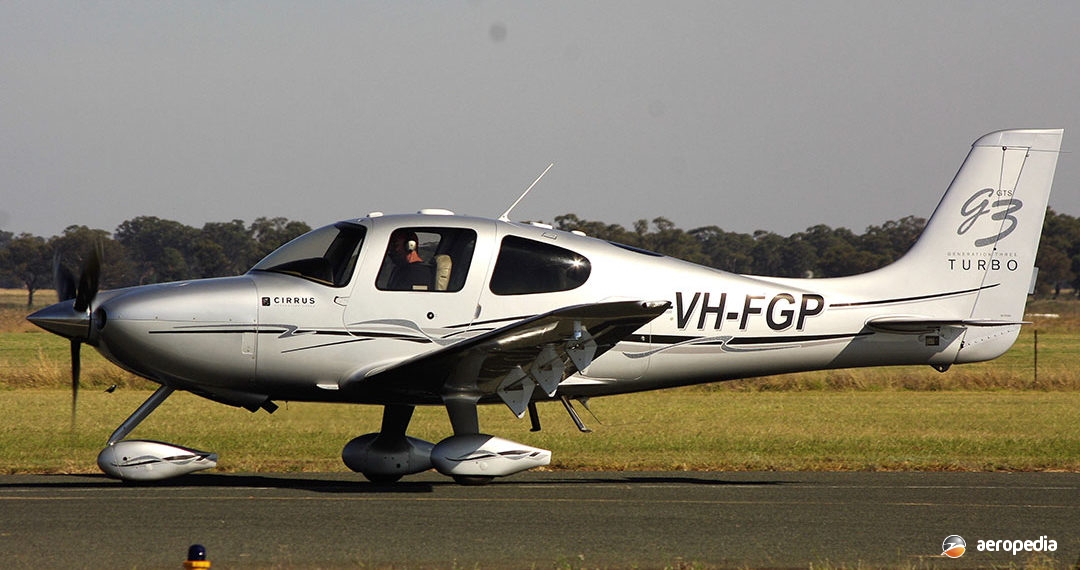Photograph:
Cirrus SR-22 G3 VH-FGP (c/n 2866) at Temora, NSW in April 2012 (David C Eyre)
Country of origin:
United States of America
Description:
Four-seat cabin monoplane
Power Plant:
One 231 kw (310 hp) Continental IO-550-N six-cylinder horizontally-opposed air-cooled engine
Specifications:
- Wingspan: 11.73 m (38 ft 6 in)
- Length: 7.92 m (26 ft)
- Height: 2.8 m (9 ft 2 in)
- Wing area: 13.46 m² (144.9 sq ft)
- Max cruising speed: 333 km/h (206 mph)
- Initial rate of climb: 427 m/min (1,400 ft/min)
- Service ceiling: 5,334 m (17,500 ft)
- Range at max cruising speed: 1,378 km (856 miles)
- Max range at economical cruising speed: 1,850 km (1,150 miles)
- Empty weight: 1,021 kg (2,250 lb)
- Loaded weight: 1,542 kg (3,400 lb)
History:
Following the success of the SR-20 series, Cirrus developed the larger and more powerful SR-22 series, the first of which was shown at the United States Aircraft Owners and Pilots Association meeting (AOPA) in Florida in 2000. This new aircraft embodied much new technology, with a composite airframe, class cockpit, all-electric systems, sidestick controls, and single-lever power/propeller control.
The new model immediately became very popular, becoming the highest selling fully certified piston-engine light aircraft in 2003, with 355 examples delivered. Deliveries of production SR-22s began in February 2001, and this became the best-selling Cirrus model, a total of 475 being delivered in 2005 alone.
Societe de Motorisations Aeronautiques (SMA) was formed in 1997 as a joint venture between Aerospatiale, Renault and Snecma to produce engines for the light aircraft market, and one unit which has been very successful was the SMA-SR305-230, a four-cylinder 305 cubic-inch direct-injection diesel producing 172 kw (230 hp) which became available in the SR-22 as an option, and has been installed in a number of other aircraft types.
The SR-22 came standard with a glass cockpit layout and the Cirrus Airframe Parachute System (CAPS), a ballistic parachute that could be deployed by pulling a lever in the cockpit in the event of an emergency, and could be used in the event of pilot incapacitation or an un-intentional spin, which lowered the aircraft to the ground.
A number of SR-22s have been imported to this region. In July 2005 the 2,000th Cirrus was delivered, this being an SR-22 GTS. Production was proceeding at a rate of 12 aircraft per week.
First of the type seen in New Zealand was an SR-22-G2 (N698CD) which made a sales tour of the country, two aircraft being sold during the tour, the aircraft being delivered by air from the production facility at Duluth in Minnesota.
More than 80 examples of the SR-20 and SR-22 series have been registered in this region.
Development of the series has continued, the performance being improved in the SR-22 Turbo by the installation of a Teledyne Continental Platinum IO-550-N turbocharged six-cylinder engine producing 231 kw (310 hp) at 2,700 rpm, driving a Hartzell Scimitar Select three-blade composite constant-speed propeller. It had a max cruising speed of 391 km/h (243 mph) and a service ceiling of 7,620 m (25,000 ft). This model was fitted with an Avidyne Entegra glass cockpit which consisted of a flat-panel EXP5000 Primary Flight Display and an EX5000 Multi-Function Display.
In early 2014 the first example of the SR-22 GTS (N802DK) arrived in New Zealand on a demonstration tour, later flying to Australia and being demonstrated. This model joined the range alongside the SR-20 with a 149 kw (200 hp) engine, the SR-22 with a 231 kw (310 hp) engine and the SR-22T with a 235 kw (315 hp) engine. The GTS had the max take-off-weight increased by 91 kg (200 lb), the installation of Bermger brakes, strengthened high-speed flaps, an ADS-B transponder, a Garmin GFC-700 autopilot as standard, and a larger ballistic parachute which had a fail-safe electronic ignition in place of the previous power charge igniter which was described as a Generation 5 airframe.
The parachute was used to great effect in this aircraft on Saturday, 10 May 2014, when, whilst flying west of Sydney, NSW over the Blue Mountains with four persons on board, the aircraft N02DK (c/n 4046) “suffered an engine failure” and the parachute brought the aircraft to the ground safely, allowing the pilot and passengers to escape relatively unharmed but with some damage to the aircraft and the fence of a local home. This was the second occasion the ballistic parachute on an SR-22 has been used in Australia, the first being on VH-SLS (c/n 3308) when it ditched into the sea near Hamilton Island, QLD on 24 December 2009.
More than 140 examples of the various models have now been registered in Australia, and five in New Zealand.
The first of the new Generation 5 series with light-weight brakes, new generation software and a larger parachute was registered in Australia, becoming VH-ICE (c/n 4063) in 2014.

